Clash of the Titans - TT Tai Chi vs. CM Stacker 830
by Joshua Buss on February 23, 2006 12:05 AM EST- Posted in
- Cases/Cooling/PSUs
Thermaltake Tai Chi
Thermaltake knows how to make a good case. This has been shown to be true time and time again both by our site and many others. A subdivision of theirs, Thermalrock, ran away with a gold editor's choice award in our large 8-way comparison for its excellent Eclipse case, and although never published, a close examination of their Armor case also bore out this claim as it is a fine unit capable of just about anything that one could ever want in a computer case. So, how does one improve upon cases as nice as the Armor and Eclipse, exactly? Well for starters, you don't remove any of the features that made the predecessors so popular.
Like the armor, the most prominent feature of the Tai Chi is the staggering number of externally available 5¼” drive bays – 11 to be exact. While there is one bay that's already assumed used for the 3½” drive/ power+reset buttons/LED indicators unit, it's still technically optional, as is the accessory tray and hard drive cage. Even with all three of these units in place, however, the Tai Chi could hold any of the following possible configurations: an additional six 5¼” drives; three 5¼” drives and an additional three hard drives; or two more hard drive cages for a total of nine hard drives. The storage options alone will be reason enough for some people to jump right on this unit. With this much capacity comes a price – and that price is size. The Tai Chi is massive.
Getting past the amazing drive capacity and size is just the beginning, however; the Thermaltake flagship case doesn't look like a giant radiator for nothing. Solid 1/8” think aluminum panels lining both sides absorb much of the computer's excess heat and passively vent it to the surrounding air.
The right side of the case, being almost entirely void of anything interesting, is even more monolithic in appearance than the left. To break up the monotony and give the case its own flair, Thermaltake uses two overlapping flaps to conceal the front drives.
The inner flap is anodized black, and when partially covered by the silver flap, helps to spice up the otherwise all-silver look and give the case a very stylish curved theme when viewed from the front. Besides simply looking cool, these over-sized half-doors should provide some decent protection considering their thickness, something that we questioned with the Armor's “flaps”. In addition to beefy door panels, the Tai Chi comes with two solid aluminum handles to help move the beast around, which are not even really optional anymore on a case this size. Nonetheless, they are a well-executed addition, and are completely removable if desired.
Here, we can take a closer look at the actual finish of the Tai Chi and the layout of the top of the unit. Notice how the paint job actually leaves the aluminum with a metallic speckled look. The pictures don't even really do it justice, as it almost comes across as a brilliant platinum more so than a normal silver anodization. The port cluster for the Tai Chi is on top, and unfortunately, it places all the ports very close to each other, but that's starting to become less and less of a problem as USB devices continue to shrink. With the USB, FireWire, and audio jacks so far back on the top of the unit, Thermaltake was locking themselves into users placing this case on the ground, but with a case this large, we don't think that many users would object to this restraint – this case would simply look out of place on top of most desks.
The left side of the Tai Chi is all business. Massive holes open the warmest area of the interior completely to the outside, while large aluminum fins do the rest of the work in terms of whisking away heat from the computer. The various visible screws are what hold the three individual panels in place, but can be taken out if work needs to be done on any panel.
Thermaltake knows how to make a good case. This has been shown to be true time and time again both by our site and many others. A subdivision of theirs, Thermalrock, ran away with a gold editor's choice award in our large 8-way comparison for its excellent Eclipse case, and although never published, a close examination of their Armor case also bore out this claim as it is a fine unit capable of just about anything that one could ever want in a computer case. So, how does one improve upon cases as nice as the Armor and Eclipse, exactly? Well for starters, you don't remove any of the features that made the predecessors so popular.
Like the armor, the most prominent feature of the Tai Chi is the staggering number of externally available 5¼” drive bays – 11 to be exact. While there is one bay that's already assumed used for the 3½” drive/ power+reset buttons/LED indicators unit, it's still technically optional, as is the accessory tray and hard drive cage. Even with all three of these units in place, however, the Tai Chi could hold any of the following possible configurations: an additional six 5¼” drives; three 5¼” drives and an additional three hard drives; or two more hard drive cages for a total of nine hard drives. The storage options alone will be reason enough for some people to jump right on this unit. With this much capacity comes a price – and that price is size. The Tai Chi is massive.
Getting past the amazing drive capacity and size is just the beginning, however; the Thermaltake flagship case doesn't look like a giant radiator for nothing. Solid 1/8” think aluminum panels lining both sides absorb much of the computer's excess heat and passively vent it to the surrounding air.
The right side of the case, being almost entirely void of anything interesting, is even more monolithic in appearance than the left. To break up the monotony and give the case its own flair, Thermaltake uses two overlapping flaps to conceal the front drives.
The inner flap is anodized black, and when partially covered by the silver flap, helps to spice up the otherwise all-silver look and give the case a very stylish curved theme when viewed from the front. Besides simply looking cool, these over-sized half-doors should provide some decent protection considering their thickness, something that we questioned with the Armor's “flaps”. In addition to beefy door panels, the Tai Chi comes with two solid aluminum handles to help move the beast around, which are not even really optional anymore on a case this size. Nonetheless, they are a well-executed addition, and are completely removable if desired.
Here, we can take a closer look at the actual finish of the Tai Chi and the layout of the top of the unit. Notice how the paint job actually leaves the aluminum with a metallic speckled look. The pictures don't even really do it justice, as it almost comes across as a brilliant platinum more so than a normal silver anodization. The port cluster for the Tai Chi is on top, and unfortunately, it places all the ports very close to each other, but that's starting to become less and less of a problem as USB devices continue to shrink. With the USB, FireWire, and audio jacks so far back on the top of the unit, Thermaltake was locking themselves into users placing this case on the ground, but with a case this large, we don't think that many users would object to this restraint – this case would simply look out of place on top of most desks.
The left side of the Tai Chi is all business. Massive holes open the warmest area of the interior completely to the outside, while large aluminum fins do the rest of the work in terms of whisking away heat from the computer. The various visible screws are what hold the three individual panels in place, but can be taken out if work needs to be done on any panel.


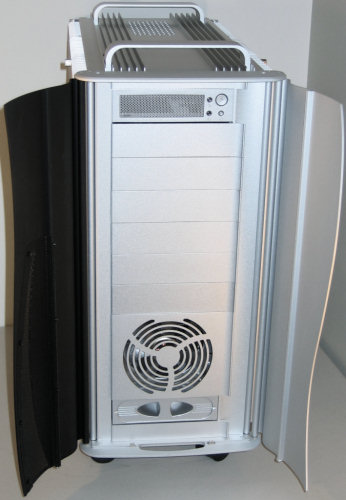
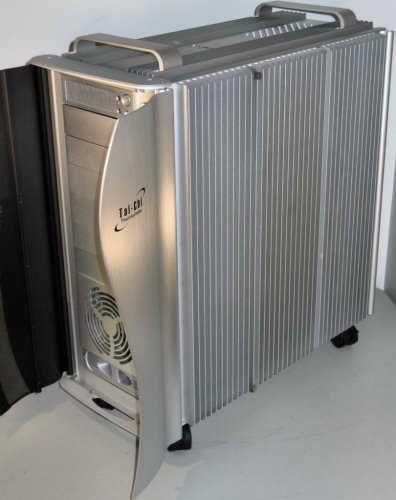
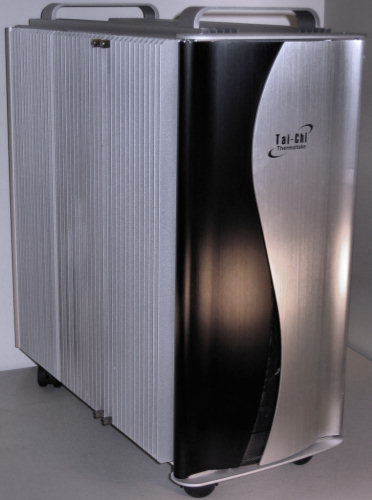
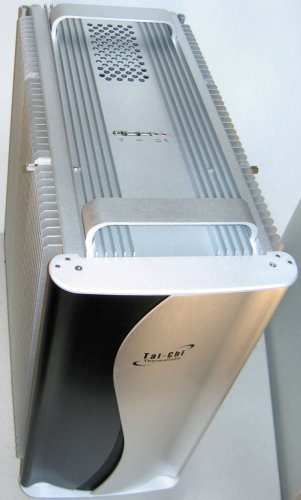
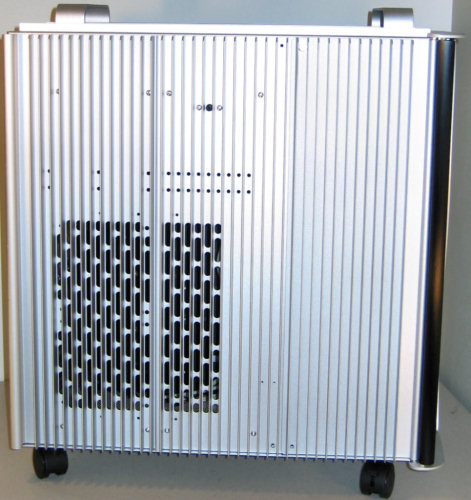








55 Comments
View All Comments
Tamale - Friday, February 24, 2006 - link
I made the most prominent mention of it right before the sound chart:"With the finding that the Tai Chi cools just as well as the Stacker 830 with half as many fans, one has to wonder if that means that the Thermaltake fans are making substantially more noise. To see if that's the case, we used our sound pressure level (SPL) meter and rated the system's noise subjectively on a scale from 1 to 10."
Even without taking the fans into consideration, the two cases' temperatures were very, very close. Look at the HTPC roundup to see how much they've different in the past.
JoshuaBuss - Friday, February 24, 2006 - link
1) It's ok for different people to have different definitions of 'high-end'. For me, a great case for a decent price is higher-end than a case that costs twice as much and doesn't offer as much.2) I mention the passive radiative design of the Tai Chi as a benefit, but perhaps didn't stress enough that the design is for the most part a waste unless one attaches additional cooling equipment to the sides so that conduction of heat to the fins would actually take place. What is true is that the case cools exceptionally well with only two fans. Is it the fins helping? While certainly I agree with you that they're not helping that much, I would still say that they're helping a little.
3) The cage itself lacks any active defense against vibrations unfortunately. Its design is of thinner material that has more bends to it, so inherantely it will aborb a little bit of the vibrations, but not much. We really preferred CM's cage in this regard, for this and the 4 drive capacity. That being said, seagate barracuda drives are still very, very quiet in the Tai Chi.
fsardis - Friday, February 24, 2006 - link
making the case out of alu does help dissipate heat from inside. the hot air does make the alu hotter and the fins increase the contact area with the ambient air.the only proper argument against the heat sink design is that although it has fins to dissipate heat outside, it doesnt have a large contact area inside so the hot air of the interior wont transfer heat to the alu as fast. then again all this applies only in cases of passive cooling. with active cooling the whole heatsink design is wasted since the hot air gets thrown out and fresh air comes in.
i am the owner of a stacker 830 and i am disapointed to say the least. there is not a single spot in the case to mount even a single water cooling rad. having read so many reviews on the net about how this case is good for water cooling, i seriously question the validity of other reviewers and not of the anandtech reviewer.
ATWindsor - Friday, February 24, 2006 - link
I doubt the difrence between fins and no fins when the side only has contact with air is within uncertanties int he measurments, i see it as little more than a gimmick. And aluminum in itself also have little improvment in heat (over steel).LoneWolf15 - Thursday, February 23, 2006 - link
can be a pain already, but the dual-doors like on the Tai Chi are worse than a single one, IMO. It can make it really hard to put a case under a desk, or in a small area, and I would get really tired of having to open two doors every time I wanted access to one of my drives (which is why I got an Antec P-160, which stealths the optical/floppy drives quite nicely without needing doors).I like the CoolerMaster's design. Still not a fan of a door on a case, but it seems cleaner than Thermaltake, whose cases have always come off as somewhat gimmicky to me.
Good review, guys.
JoshuaBuss - Thursday, February 23, 2006 - link
The dual-doors aren't really as bad as you'd might think, but yes, it will definitely be a problem unless you have a large open space to the left of the tower... that is of course only if you care about opening it at all.. hehkalaap - Thursday, February 23, 2006 - link
I don't think this case is made for small spaces.latino666 - Thursday, February 23, 2006 - link
Uhh I can't see the pictures anyone know reason why?Also I did use Firefox and IE
ATWindsor - Thursday, February 23, 2006 - link
For some odd reason i don't get up pictures on anand anymore if i disable referer-logging, could that be the case for you?TallCoolOne - Thursday, February 23, 2006 - link
I also cannot see the pics, and also tried both Firefox and IE.